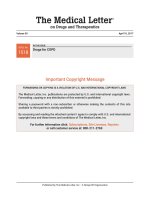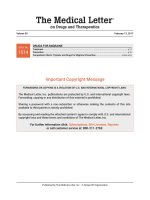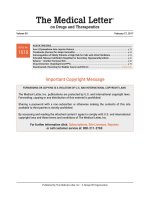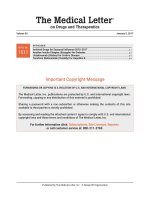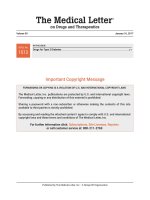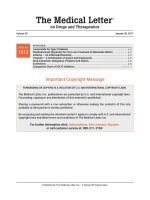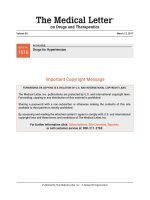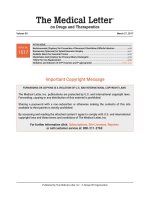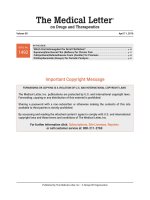The medical letter on drugs and therapeutics janurary 2 2017
Bạn đang xem bản rút gọn của tài liệu. Xem và tải ngay bản đầy đủ của tài liệu tại đây (253.6 KB, 11 trang )
The Medical Letter
®
on Drugs and Therapeutics
Volume 59
ISSUE
ISSUE
No.
1433
1511
Volume 56
January 2, 2017
IN THIS ISSUE
Antiviral Drugs for Seasonal Influenza 2016-2017 .............................................................. p 1
Another Insulin Glargine (Basaglar) for Diabetes.................................................................. p 3
Ustekinumab (Stelara) for Crohn’s Disease .......................................................................... p 5
Tenofovir Alafenamide (Vemlidy) for Hepatitis B.................................................................. p 6
Important Copyright Message
FORWARDING OR COPYING IS A VIOLATION OF U.S. AND INTERNATIONAL COPYRIGHT LAWS
The Medical Letter, Inc. publications are protected by U.S. and international copyright laws.
Forwarding, copying or any distribution of this material is prohibited.
Sharing a password with a non-subscriber or otherwise making the contents of this site
available to third parties is strictly prohibited.
By accessing and reading the attached content I agree to comply with U.S. and international
copyright laws and these terms and conditions of The Medical Letter, Inc.
For further information click: Subscriptions, Site Licenses, Reprints
or call customer service at: 800-211-2769
Published by The Medical Letter, Inc. • A Nonprofit Organization
The Medical Letter publications are protected by US and international copyright laws.
Forwarding, copying or any other distribution of this material is strictly prohibited.
For further information call: 800-211-2769
The Medical Letter
®
on Drugs and Therapeutics
Volume 59
January 2, 2017
Take CME Exams
ISSUE
ISSUE No.
1433
1511
Volume 56
ALSO IN THIS ISSUE
Another Insulin Glargine (Basaglar) for Diabetes.................................................................. p 3
Ustekinumab (Stelara) for Crohn’s Disease .......................................................................... p 5
Tenofovir Alafenamide (Vemlidy) for Hepatitis B.................................................................. p 6
We asked you what topics you wanted to see more of in The
Medical Letter, and you told us. So as this new year begins,
you will soon see, in addition to our traditional coverage,
more articles reviewing all of the drugs used to treat common
conditions such as diabetes, hypertension, migraine, and
asthma appearing in our issues on a regular basis. With so
much to cover, you may also see our issues increase in length
and more articles published only online. Remember to visit our
website or mobile app regularly for additional content and to
earn free CME credits and ABIM MOC points. Happy New Year!
▶
Antiviral Drugs for Seasonal
Influenza 2016-2017
Antiviral drugs can be used for prophylaxis and treatment
of influenza. Frequently updated information on influenza
activity, testing for influenza, and antiviral resistance is
available from the CDC at www.cdc.gov/flu.
INDICATIONS FOR TREATMENT — The CDC
recommends starting antiviral treatment as soon as
possible after illness onset, without waiting for the
results of influenza testing. Antiviral treatment is
indicated for all persons with suspected or confirmed
influenza who are at high risk for complications,
including children <2 years old, persons <19 years
old receiving long-term aspirin therapy, adults ≥65
years old, morbidly obese persons (BMI ≥40), women
who are pregnant or ≤2 weeks postpartum, persons
of American Indian/Alaska Native heritage, residents
of nursing homes or other chronic care facilities, and
persons who are immunosuppressed or have certain
chronic medical conditions (including pulmonary,
cardiovascular,
renal,
hepatic,
hematological,
metabolic, neurologic, or neurodevelopmental
disorders). Antiviral treatment is recommended for
all patients with suspected or confirmed influenza
who have severe, complicated, or progressive illness,
develop symptoms of lower respiratory tract infection,
or require hospitalization. Antiviral treatment can
be considered for previously healthy persons with
uncomplicated influenza if it can be started within 48
hours of illness onset.1
Recommendations for Treatment of Seasonal Influenza
▶ Antiviral treatment should be started as soon as possible
▶
▶
▶
▶
▶
after illness onset, without waiting for the results of influenza
testing.
Treatment is indicated for persons with influenza who are at
high risk for complications (including pregnant women), have
severe illness, or are hospitalized.
Treatment can be considered for previously healthy persons
with uncomplicated influenza if it can be started within 48
hours of illness onset.
Neuraminidase inhibitors (oral oseltamivir, inhaled zanamivir,
or IV peramivir) are the drugs of choice.
These drugs are most effective when started within 48 hours
of illness onset.
Oseltamivir is preferred for treatment of pregnant women and
hospitalized patients.
INDICATIONS FOR CHEMOPROPHYLAXIS — Antiviral
prophylaxis is not recommended for healthy persons
exposed to influenza. It can be considered for persons at
high risk for complications who have not been vaccinated
against influenza this season, have received the vaccine
within the last 2 weeks or are unlikely to respond to
vaccination, for unvaccinated healthcare workers who
are exposed to influenza, and to help control outbreaks
in nursing homes.
NEURAMINIDASE INHIBITORS — Neuraminidase
inhibitors remain the drugs of choice for treatment
and prophylaxis of influenza. Oseltamivir (Tamiflu,
and generic), which is taken orally, and zanamivir
(Relenza), which is inhaled, are approved by the FDA
for treatment of acute, uncomplicated influenza in
children and adults; both drugs are also approved for
influenza prophylaxis. A single intravenous dose of
peramivir (Rapivab) is FDA-approved for treatment of
acute uncomplicated influenza in adults.2
Effectiveness – When used for prophylaxis against
susceptible strains of seasonal influenza A or B
viruses, neuraminidase inhibitors have generally been
about 70-90% effective.3
Use of neuraminidase inhibitors for treatment of influenza
can shorten the duration of symptoms by about one
1
Published by The Medical Letter, Inc. • A Nonprofit Organization
The Medical Letter
January 2, 2017
Vol. 59 (1511)
®
Table 1. Antiviral Drugs for Prophylaxis and Treatment of Seasonal Influenza 2016-2017
Drug
Oseltamivir (Tamiflu, and generic)
Zanamivir (Relenza)1
Formulations
30, 45, 75 mg caps;
6 mg/mL oral susp (Tamiflu only)
5 mg/blister for inhalation
Cost3
generic: $127.504
Tamiflu: 143.00
$59.00
Peramivir (Rapivab)
2
200 mg/20 mL single-use
vials
$950.00
Prophylaxis of Influenza
Adult Dosage
75 mg PO once daily x 7 days5
2 inhalations once daily x 7 days5
Not FDA-approved for prophylaxis
Adult Dosage
for Renal
Impairment
CrCl 30-60 mL/min: 30 mg once daily
CrCl >10-30 mL/min: 30 mg every other day
HD: 30 mg after every other HD6
CAPD: 30 mg once/week after exchange
ESRD not on HD: not recommended
No dosage adjustment required
for renal impairment
Not FDA-approved for prophylaxis
≥5 yrs: 2 inhalations once daily
x 7 days5
Not FDA-approved for prophylaxis
Pediatric Dosage 30-75 mg7 PO once daily x 7 days5
Treatment of Uncomplicated Influenza
Adult Dosage
75 mg PO bid x 5 days8
2 inhalations bid x 5 days
600 mg IV once8
Adult Dosage
for Renal
Impairment
CrCl 30-60 mL/min: 30 mg bid
CrCl >10-30 mL/min: 30 mg once daily
HD: 30 mg after every HD
CAPD: 30 mg after exchange
ESRD not on HD: not recommended
No dosage adjustment
required for renal impairment
CrCl 30-49 mL/min: 200 mg once
CrCl 10-29 mL/min: 100 mg once
HD: administer dose (based
on CrCl) after HD
≥7 yrs: 2 inhalations bid x 5 days
Not FDA-approved for use in children
Pediatric Dosage 30-75 mg7 PO bid x 5 days8
CAPD = continuous ambulatory peritoneal dialysis; ESRD = end-stage renal disease; HD = hemodialysis
1. Inhaled zanamivir is not recommended for use in patients with underlying respiratory disease such as asthma or COPD or in patients with severe influenza,
including hospitalized patients. Contraindicated in patients with a history of allergy to milk protein.
2. Available in a carton containing 5 rotadisks (each rotadisk contains four 5-mg blisters of the active drug in a lactose carrier) and a Diskhaler inhalation device.
Zanamivir should not be used in a nebulizer.
3. Approximate WAC for 5 days’ treatment with oseltamivir or zanamivir, or a single dose of peramivir at the adult dosage. WAC = wholesaler acquisition cost or manufacturer’s published price to wholesalers; WAC represents a published catalogue or list price and may not represent an actual transactional price. Source: AnalySource®
Monthly. December 5, 2016. Reprinted with permission by First Databank, Inc. All rights reserved. ©2016. www.fdbhealth.com/policies/drug-pricing-policy.
4. Cost at www.healthwarehouse.com. Accessed December 20, 2016.
5. After the last known exposure. For prophylaxis of exposures in institutions, the drug should be taken for at least 2 weeks and continued for 1 week after the end
of the outbreak. For prophylaxis during community outbreaks, oseltamivir has been shown to be effective and safe when taken for up to 42 days, and zanamivir
for up to 28 days. Some expert clinicians would use twice-daily therapeutic doses for post-exposure prophylaxis in highly immunocompromised persons.
6. Initial dose can be administered before start of HD.
7. Dose for children 1-12 yrs old: ≤15 kg: 30 mg; 15.1-23 kg: 45 mg; 23.1-40 kg: 60 mg; ≥40.1 kg: 75 mg. The FDA-approved dosage for treatment of infants
≥2 weeks to <1 year old is 3 mg/kg bid; the CDC recommends the same dosage for treatment of children <2 weeks old. Although not FDA-approved for prophylaxis in children <1 year old, the ACIP and CDC recommend that children 3-11 months old receive 3 mg/kg once/d. For treatment of premature infants, refer to
CDC recommendations (www.cdc.gov/flu).
8. In hospitalized, critically ill, or immunocompromised patients a longer treatment course of oseltamivir (e.g., 10 days) is often used. Oseltamivir can be administered by oro/nasogastric tube to patients who are unable to swallow capsules. IV peramivir (for at least 5 days) or investigational IV zanamivir may be
considered for those who cannot take oseltamivir. IV zanamivir is available under an emergency investigational new drug request to the manufacturer (GSK
877-626-8019) for hospitalized patients with severe influenza.
day.4,5 Although most controlled trials of these drugs have
not been powered to assess their efficacy in preventing
serious influenza complications, expert clinicians have
generally interpreted the combined results of controlled
trials, observational studies, and meta-analyses as
showing that early antiviral treatment of high-risk patients
with influenza may reduce the risk of complications.6
Timing and Duration – When indicated, prophylaxis
with oseltamivir or zanamivir should be started within
48 hours after exposure to the influenza virus and
continued for 7 days after the last known exposure.
Longer durations of prophylaxis are often recommended
for institutional and community outbreaks (see Table 1).
Treatment of influenza with a neuraminidase inhibitor
is most effective when started within 48 hours after
illness onset; however, the results of some observational studies in hospitalized and critically ill patients
suggest that treatment started as late as 4-5 days after illness onset may reduce the risk of complications
such as pneumonia, respiratory failure, and death.7-9
2
The usual duration of treatment for patients with
uncomplicated influenza is 5 days with oseltamivir
or zanamivir and 1 day with peramivir. For hospitalized, critically ill, or immunocompromised patients,
in whom viral replication may be protracted, a longer
treatment course of oseltamivir (e.g., 10 days) is often
used. IV peramivir (for at least 5 days) or investigational IV zanamivir may be considered for those who
cannot take oseltamivir.1
Pregnancy — Pregnant women are at high risk for
complications of influenza, including death.10 Prompt
antiviral treatment is recommended for women with
suspected or confirmed influenza who are pregnant or
≤2 weeks postpartum. Oseltamivir and zanamivir appear
to be safe for use during pregnancy, but oseltamivir is
preferred for treatment.11-13 Antiviral prophylaxis can be
considered for pregnant women who have had close
contact with someone likely to have been infected with
influenza. Zanamivir may be preferred for prophylaxis
because of its limited systemic absorption, but
oseltamivir is a reasonable alternative.
The Medical Letter
®
Resistance – Most of the recently circulating virus
strains tested by the CDC have been susceptible
to neuraminidase inhibitors.14 Resistance of some
influenza virus strains (particularly influenza A
[H1N1]) to oseltamivir or peramivir can emerge during
or after treatment, especially in immunocompromised
patients with prolonged viral shedding.15,16 Resistant
isolates have generally remained susceptible to
zanamivir, but reduced susceptibility to zanamivir has
been reported.17
Adverse Effects – Nausea, vomiting, and headache
are the most common adverse effects of oseltamivir;
taking the drug with food may minimize gastrointestinal adverse effects. Diarrhea, nausea, sinusitis,
fever, and arthralgia have been reported with zanamivir.
Inhalation of zanamivir can cause bronchospasm; the
drug should not be used in patients with underlying
airway disease. Diarrhea and neutropenia have
occurred with peramivir. Neuropsychiatric events,
including self-injury and delirium, have been reported in
patients taking neuraminidase inhibitors, but a causeand-effect relationship has not been established, and
neuropsychiatric dysfunction is a known complication
of influenza illness.18
Neuraminidase inhibitors administered within 48
hours before or <2 weeks after administration of the
intranasal live-attenuated influenza vaccine (FluMist
Quadrivalent) may interfere with the vaccine’s efficacy.
The live-attenuated vaccine is not recommended for
use during the 2016-2017 influenza season because
it has been less effective than the inactivated vaccine
in recent seasons.19 Inactivated influenza vaccine can
be given at any time relative to use of a neuraminidase
inhibitor. ■
1. CDC. Influenza antiviral medications: summary for clinicians. Available at: www.cdc.gov/flu/professionals/antivirals/
summary-clinicians.htm. Accessed December 20, 2016.
2. Peramivir (Rapivab): an IV neuraminidase inhibitor for treatment of influenza. Med Lett Drugs Ther 2015; 57:17.
3. AE Fiore et al. Antiviral agents for the treatment and chemoprophylaxis of influenza – recommendations of the Advisory Committee on Immunization Practices (ACIP). MMWR Recomm Rep
2011; 60:1.
4. J Dobson et al. Oseltamivir treatment for influenza in adults:
a meta-analysis of randomised controlled trials. Lancet 2015;
385:1729.
5. IDSA. Statement by the Infectious Disease Society of America
(IDSA) on the recent publication on "Neuraminidase inhibitors
for preventing and treating influenza in healthy adults and children." April 2014. Available at: www.idsociety.org/influenza_
statement.aspx. Accessed December 20, 2016.
6. In brief: Concerns about oseltamivir (Tamiflu). Med Lett Drugs
Ther 2015; 57:14.
7. JK Louie et al. Neuraminidase inhibitors for critically ill children
with influenza. Pediatrics 2013; 132:e1539.
Vol. 59 (1511)
January 2, 2017
8. SG Muthuri et al. Effectiveness of neuraminidase inhibitors in
reducing mortality in patients admitted to hospital with influenza A H1N1pdm09 virus infection: a meta-analysis of individual participant data. Lancet Respir Med 2014; 2:395.
9. JK Louie et al. Treatment with neuraminidase inhibitors for
critically ill patients with influenza A (H1N1)pdm09. Clin Infect
Dis 2012; 55:1198.
10. MH Yudin. Risk management of seasonal influenza during pregnancy: current perspectives. Int J Womens Health 2014; 6:681.
11. IK Oboho et al. Benefit of early initiation of influenza antiviral
treatment to pregnant women hospitalized with laboratoryconfirmed influenza. J Infect Dis 2016; 214:507.
12. LM Ghulmiyyah et al. Influenza and its treatment during pregnancy: a review. J Neonatal Perinatal Med 2015; 8:297.
13. CDC. Recommendations for obstetric health care providers related to use of antiviral medications in the treatment and prevention of influenza. Available at: www.cdc.gov/flu/professionals/
antivirals/avrec_ob.htm. Accessed December 20, 2016.
14. AC Hurt et al. Global update on the susceptibility of human
influenza viruses to neuraminidase inhibitors, 2014-2015. Antiviral Res 2016; 132:178.
15. QM Le et al. A community cluster of oseltamivir-resistant
cases of 2009 H1N1 influenza. N Engl J Med 2010; 362:86.
16. C Renaud et al. H275Y mutant pandemic (H1N1) 2009 virus
in immunocompromised patients. Emerg Infect Dis 2011;
17:653.
17. E Takashita et al. Influenza A(H1N1)pdm09 virus exhibiting
enhanced cross-resistance to oseltamivir and peramivir due
to a dual H275Y/G147R substitution, Japan, March 2016. Euro
Surveill 2016; 21(24): Article 2.
18. S Toovey et al. Post-marketing assessment of neuropsychiatric adverse events in influenza patients treated with oseltamivir: an updated review. Adv Ther 2012; 29:826.
19. Influenza vaccine for 2016-2017. Med Lett Drugs Ther 2016;
58:127.
▶
Another Insulin Glargine
(Basaglar) for Diabetes
Revised 1/20/17: See page 4
The FDA has approved Basaglar (Lilly/Boehringer
Ingelheim), a “follow-on” 100 units/mL insulin glargine
product similar to Lantus (Sanofi), which recently
went off patent. A 300 units/mL formulation of insulin
glargine (Toujeo) was approved in 2015.1
Pronunciation Key
Basaglar: baze' uh glar
INSULIN GLARGINE — A recombinant DNA analog of
human insulin, insulin glargine forms microprecipitates
in subcutaneous tissue, prolonging its duration of
action to a mean of about 24 hours.2 It has less
peak-to-trough variation and causes less nocturnal
hypoglycemia than NPH insulin.
CLINICAL STUDIES — Approval of Basaglar was
based on data demonstrating the clinical efficacy and
safety of Lantus.3 Comparative studies have found
no significant differences in the pharmacokinetics,
toxicity, or immunogenicity of Lantus and Basaglar.4,5
3
Revised 1/20/17: In the Dosage and Administration paragraph, we removed the word “syringe” in describing Basaglar’s KwikPen device. Basaglar is not available as a prefilled
syringe; it is only available as a KwikPen.
The Medical Letter
January 2, 2017
Vol. 59 (1511)
®
Table 1. Insulin Glargine Products
Drug
Concentration
Some Formulations
Onset
Duration
Cost1
Basaglar (Lilly/Boehringer Ingelheim)
Lantus (Sanofi)
Toujeo (Sanofi)
100 units/mL
100 units/mL
300 units/mL
3 mL KwikPen
3 mL SoloStar pen; 10 mL vial
1.5 mL SoloStar pen
1-4 hrs
1-4 hrs
1-6 hrs
~24 hrs
22-26 hrs
24-36 hrs
$63.40
74.60
111.80
2
1. Approximate WAC for one prefilled pen. WAC = wholesaler acquisition cost or manufacturer’s published price to wholesalers; WAC represents a published catalogue
or list price and may not represent an actual transactional price. Source: AnalySource® Monthly. December 5, 2016. Reprinted with permission by First Databank, Inc.
All rights reserved. ©2016. www.fdbhealth.com/policies/drug-pricing-policy.
2. H Linnebjerg et al. Diabetes Obes Metab 2016 Aug 3 (epub).
Basaglar was compared to Lantus in two noninferiority
trials in adults with type 1 or type 2 diabetes. In an
open-label trial, 535 patients with type 1 diabetes
were randomized to receive Basaglar or Lantus, both
in combination with mealtime insulin lispro.6 In a
double-blind, controlled trial, 756 patients with type 2
diabetes who were taking ≥2 oral antihyperglycemic
drugs were randomized to receive Basaglar or Lantus
in addition to their oral medications.7 In both studies,
decreases in mean HbA1c values from baseline to 24
weeks, the primary endpoint, were similar with the two
insulin glargine products.
ADVERSE EFFECTS — In clinical trials, the incidence of
adverse effects, including nocturnal hypoglycemia and
weight gain, was similar with Basaglar and Lantus.
Both drugs can cause injection-site reactions.
REGULATORY STATUS — Even though Basaglar is highly
similar to Lantus in composition, strength, presentation,
and in its physicochemical, structural, and biological
properties, and appears to produce the same clinical
results, it was not designated as a biosimilar or an
interchangeable biologic product by the FDA because
of a regulatory technicality: insulin is classified as a
chemical, not a biological, entity, so there is no biologic
reference product for insulin glargine. Pharmacists
generally cannot substitute Basaglar for Lantus without
the permission of the prescriber.
PREGNANCY AND LACTATION — There are no wellcontrolled studies of insulin glargine use in pregnant
women. In rats and rabbits given up to 7 times the
recommended human starting dose of an insulin
glargine product before and during mating and
throughout pregnancy, no adverse effects on the fetus
were detected. Endogenous insulin is present in breast
milk, but whether insulin glargine is excreted in human
milk is not known.
DOSAGE AND ADMINISTRATION — Basaglar is
available in packages of five multi-dose KwikPens,
each prefilled with 3 mL of insulin glargine 100 units/
mL. A pen can deliver 1 to 80 units per injection. It
should be primed with 2 units of insulin glargine before
each injection.
4
Basaglar should be injected subcutaneously once
daily at the same time each day. Insulin-naive patients
with type 1 diabetes should start Basaglar therapy at
about one-third of their estimated total daily insulin
requirement, with the remaining requirement fulfilled
by short- or rapid-acting pre-meal insulin. In patients
with type 2 diabetes, the recommended starting
dosage of Basaglar is 0.2 units/kg or up to 10 units
once daily. Patients on Lantus can switch to Basaglar
at the same daily dosage. In patients switching from
Toujeo or from a twice-daily NPH insulin, the dosage
of Basaglar should be 80% of the previous total insulin
dosage. Patients switching to Toujeo from Lantus
or Basaglar may require about 10-15% more basal
insulin per day.
Patients previously controlled on an intermediate- or
long-acting insulin (other than insulin glargine) who
switch to Basaglar may need to adjust the dosage
of their basal insulin, short-acting insulin, or other
antihyperglycemic drugs.
CONCLUSION — Basaglar is similar to Lantus in
efficacy and safety. Patients could use either one. ■
1. Concentrated insulin glargine (Toujeo) for diabetes. Med Lett
Drugs Ther 2015; 57:69.
2. Drugs for diabetes. Med Lett Drugs Ther 2017; 59:9 (in press).
3. Center for Drug Evaluation and Research. Basaglar Summary
Review. Available at: www.accessdata.fda.gov/drugsatfda_
docs/nda/2015/205692Orig1s000SumR.pdf. Accessed December 20, 2016.
4. H Linnebjerg et al. Comparison of the pharmacokinetics and
pharmacodynamics of LY2963016 insulin glargine and EU- and
US-approved versions of Lantus insulin glargine in healthy
subjects: three randomized euglycemic clamp studies. Diabetes Care 2015; 38:2226.
5. LL Ilag et al. Evaluation of immunogenicity of LY2963016 insulin glargine compared with Lantus insulin glargine in patients
with type 1 or type 2 diabetes mellitus. Diabetes Obes Metab
2016; 18:159.
6. TC Blevins et al. Efficacy and safety of LY2963016 insulin
glargine compared with insulin glargine (Lantus) in patients
with type 1 diabetes in a randomized controlled trial: the ELEMENT 1 study. Diabetes Obes Metab 2015; 17:726.
7. J Rosenstock et al. Similar efficacy and safety of LY2963016 insulin glargine and insulin glargine (Lantus) in patients with type
2 diabetes who were insulin-naïve or previously treated with
insulin glargine: a randomized, double-blind controlled trial (the
ELEMENT 2 study). Diabetes Obes Metab 2015; 17:734.
The Medical Letter
▶
®
Ustekinumab (Stelara) for
Crohn’s Disease
The FDA has approved the human interleukin (IL)-12
and -23 antagonist ustekinumab (Stelara – Janssen
Biotech) for treatment of moderately to severely active
Crohn’s disease in adults who were intolerant of or
whose disease was unresponsive to treatment with immunomodulators or corticosteroids, or a tumor necrosis
factor (TNF) inhibitor. Ustekinumab was approved earlier for treatment of psoriasis and psoriatic arthritis.1,2
Pronunciation Key
Ustekinumab: us" te kin' ue mab
Stelara: ste lar' uh
STANDARD TREATMENT — Corticosteroids are used
to induce remission of Crohn's disease. Azathioprine
or 6-mercaptopurine (6-MP) can be used for
maintenance of remission. A TNF inhibitor alone or in
combination with azathioprine or 6-MP can be used
for both induction and maintenance of remission in
patients with moderate to severe disease.3 The integrin
receptor antagonist vedolizumab (Entyvio) can be used
in patients who do not respond to or cannot tolerate
standard treatments, including TNF inhibitors.4 Use
of natalizumab (Tysabri), another integrin receptor
antagonist, has been limited by rare occurrences of
progressive multifocal leukoencephalopathy (PML).
MECHANISM OF ACTION — Ustekinumab is a fully
human IgG1 antibody that binds to the common
p40 protein subunit of both IL-12 and -23 cytokines,
preventing activation of inflammatory and immune
responses thought to be involved in the pathogenesis
of Crohn’s disease.5
CLINICAL STUDIES — Approval of ustekinumab for
treatment of Crohn's disease was based on the results
of two 8-week induction trials (UNITI-1 and UNITI-2)
and one 44-week maintenance trial (IM-UNITI); results
of these trials are summarized in Table 1.6 Patients in
all three trials were allowed to remain on stable doses
of immunosuppressants, mesalamine, antibiotics,
and/or oral corticosteroids.
The two induction trials included a total of 1369
patients with moderately to severely active Crohn’s
disease who could not tolerate or had not adequately
responded to treatment with either ≥1 TNF inhibitor
(UNITI-1) or immunomodulators or corticosteroids
(UNITI-2). In both trials, significantly more patients
treated with ustekinumab than with placebo had a
clinical response at week 6 (the primary endpoint) and
were in clinical remission at week 8.6
Vol. 59 (1511)
January 2, 2017
Table 1. Some Clinical Trials of Ustekinumab for Treatment
of Crohn’s Disease
Trial
Induction
UNITI-13 (n=741)
Ustekinumab ~6 mg/kg4
Ustekinumab 130 mg
Placebo
UNITI-23 (n=628)
Ustekinumab ~6 mg/kg4
Ustekinumab 130 mg
Placebo
Maintenance
IM-UNITI3 (n=388)
Ustekinumab 90 mg q8 wks
Ustekinumab 90 mg q12 wks
Placebo
Clinical
Response1*
Clinical
Remission2*
34%
34%
22%
21%
16%
7%
56%
52%
29%
40%
31%
20%
59%
58%
44%
53%
49%
36%
*All differences between ustekinumab and placebo are statistically significant.
1. Primary endpoint for UNITI-1 and UNITI-2. Clinical response was defined
as a decrease from baseline in the Crohn’s Disease Activity Index (CDAI)
score of ≥100 points or a total CDAI score <150 at week 6 for UNITI-1 and
UNITI-2 and at week 44 for IM-UNITI.
2. Primary endpoint for IM-UNITI. Clinical remission was defined as a CDAI
score <150 at week 8 in UNITI-1 and UNITI-2 and at week 44 in IM-UNITI.
3. B Feagan et al. N Engl J Med 2016; 375:1946.
4. Patients who weighed ≤55 kg received 260 mg, those >55-85 kg received
390 mg, and those >85 kg received 520 mg.
In the maintenance trial (IM-UNITI), 397 patients who
had responded to ustekinumab in the 8-week trials
were randomized to receive maintenance treatment
with ustekinumab 90 mg SC every 8 or 12 weeks or
switch to placebo. Significantly more patients who
received ustekinumab were in clinical remission after
44 weeks compared to those who received placebo.6
ADVERSE EFFECTS — The most common adverse
effects reported with ustekinumab in Crohn’s disease
clinical trials were vomiting with induction treatment
and injection site erythema, pruritis, nasopharyngitis,
bronchitis, sinusitis, urinary tract infection, and
vulvovaginal candidiasis with maintenance treatment.
Ustekinumab has been associated with serious
infections, including tuberculosis; screening for
tuberculosis is recommended before starting the drug.
Hypersensitivity reactions and reversible posterior
leukoencephalopathy syndrome have also occurred.
Development of autoantibodies has been reported;
whether they reduce treatment response remains to
be determined.
The incidence of non-melanoma skin cancer (0.2%)
was similar in patients with Crohn's disease treated
with ustekinumab or placebo for one year. Other
malignancies occurred in 0.2% of patients treated
with ustekinumab and in none of those who received
placebo. In one safety analysis that included 3117
patients with psoriasis treated with ustekinumab
for 1-5 years, the incidence of malignancies other
than non-melanoma skin cancer was similar to that
expected in the general US population.7
5
The Medical Letter
Vol. 59 (1511)
®
Table 2. Some Biologics for Treatment of Crohn’s Disease
Drug
Usual Adult Dosage
Cost1
Integrin Receptor Antagonists
Natalizumab ― Tysabri
300 mg IV q4 wks
$11,594.00
(Biogen)
Vedolizumab ― Entyvio 300 mg IV at wks 0,
5212.20
(Takeda)
2, and 6, then
300 mg IV q8 wks
Interleukin (IL)-12 and -23 Antagonist
Ustekinumab ― Stelara One IV weight-based2
17,680.40
(Janssen Biotech)
dose at wk 0, then
90 mg SC q8 wks
Tumor Necrosis Factor (TNF) Inhibitors
Adalimumab ― Humira
160 mg SC at wk 0, then
8194.10
(Abbvie)
80 mg SC at wk 2, followed
by 40 mg SC every other wk
starting at wk 4
Certolizumab ― Cimzia
(UCB)
400 mg SC at wks 0, 2,
7020.30
and 4, then 400 mg SC q4 wks
Infliximab ― Remicade
(Janssen Biotech)
Inflectra4 (Celltrion)
5 mg/kg IV at wks 0, 2,
and 6, then 5-10 mg/kg
IV q8 wks
4453.103
3785.103
1. Approximate WAC for 8 weeks’ treatment at the lowest maintenance dosage. WAC = wholesaler acquisition cost or manufacturer’s published price
to wholesalers; WAC represents a published catalogue or list price and may
not represent an actual transactional price. Source: AnalySource® Monthly.
December 5, 2016. Reprinted with permission by First Databank, Inc. All
rights reserved. ©2016. www.fdbhealth.com/policies/drug-pricing-policy.
2. Recommended weight-based induction dose at week 0: ≤55 kg: 260 mg;
>55-85 kg: 390 mg; >85 kg: 520 mg.
3. Cost based on a 75-kg patient.
4. Infliximab-dyyb (Inflectra) is a Remicade biosimilar.
PREGNANCY AND LACTATION — There are no adequate studies of ustekinumab use in pregnant women.
No teratogenic or other adverse developmental effects
were observed in the fetuses of pregnant monkeys who
were given high doses of ustekinumab. In one study in
which 40 pregnant monkeys were given high doses of
ustekinumab and 20 were given placebo, there were
2 neonatal deaths in the ustekinumab group and no
deaths in the placebo group. Ustekinumab has been
detected in the milk of lactating monkeys.
DRUG INTERACTIONS — Patients should not receive
live vaccines during treatment with ustekinumab.
Proinflammatory cytokines can alter the formation of
CYP enzymes. Starting treatment with ustekinumab
may normalize CYP enzyme formation and could
alter the metabolism of CYP substrates; dosage
adjustment of substrates with narrow therapeutic
indices such as warfarin or cyclosporine may be
needed. Ustekinumab may decrease the protective
effect of allergen immunotherapy.
DOSAGE AND ADMINISTRATION — The recommended
induction dosage of ustekinumab for treatment of
Crohn’s disease is 260 mg in patients who weigh
≤55 kg, 390 mg in those >55-85 kg, and 520 mg
in those >85 kg. The induction dose should be
administered as a single IV infusion over at least
6
January 2, 2017
one hour. The recommended maintenance dosage
is 90 mg injected subcutaneously every 8 weeks.
Stelara is available for IV infusion in single-dose
vials containing 130 mg/26 mL. It is also available
for SC injection in single-dose prefilled syringes
containing 90 mg/mL and single-dose vials and
prefilled syringes containing 45 mg/0.5 mL. Patients
may use the syringes to self-inject after receiving
proper training.
CONCLUSION — Ustekinumab (Stelara), an interleukin
(IL)-12 and -23 antagonist, is effective for treatment
of moderately to severely active Crohn’s disease in
adults who have had an inadequate response to or
could not tolerate standard therapies, including tumor
necrosis factor (TNF) inhibitors. How it compares to
the other biologic agents for treatment of Crohn’s
disease remains to be determined. ■
1. Drugs for psoriasis. Med Lett Drugs Ther 2015; 57:81.
2. Drugs for psoriatic arthritis. Med Lett Drugs Ther 2015; 57:e88.
3. Drugs for inflammatory bowel disease. Med Lett Drugs Ther
2014; 56:65.
4. Vedolizumab (Entyvio) for inflammatory bowel disease. Med
Lett Drugs Ther 2014; 56:86.
5. W Strober et al. Proinflammatory cytokines underlying the inflammation of Crohn’s disease. Curr Opin Gastroenterol 2010;
26:310.
6. B Feagan et al. Ustekinumab as induction and maintenance
therapy for Crohn’s disease. N Engl J Med 2016; 375:1946.
7. KA Papp et al. Long-term safety of ustekinumab in patients
with moderate-to-severe psoriasis: final results from 5 years of
follow-up. Br J Dermatol 2013; 168:844.
▶
Tenofovir Alafenamide (Vemlidy)
for Hepatitis B
The FDA has approved tenofovir alafenamide
(Vemlidy – Gilead) for treatment of chronic hepatitis
B virus (HBV) infection in adults with compensated
liver disease. It is the first single-drug product
containing tenofovir alafenamide (TAF), a prodrug of
the nucleotide reverse transcriptase inhibitor tenofovir,
to become available; several combination products
containing TAF are approved for treatment of HIV-1
infection. Tenofovir disoproxil fumarate (TDF; Viread –
Gilead), another tenofovir prodrug, has been used for
many years for treatment of chronic HBV infection;
a generic formulation of TDF is expected to become
available in December 2017.
Pronunciation Key
Tenofovir alafenamide: ten of' oh veer al" a fen' a mide
Vemlidy: vem li' dee
The Medical Letter
Vol. 59 (1511)
®
STANDARD TREATMENT — The goal of chronic HBV
treatment is to reduce the risk of cirrhosis, hepatic
failure, and hepatocellular carcinoma. Effective therapy
can reduce the viral load and promote HBV e-antigen
seroconversion (loss of HBeAg with development of
HBe antibodies); loss of HBV surface antigen (HBsAg) is
uncommon. Peginterferon alfa-2a (PEG-IFN; Pegasys),
entecavir (Baraclude, and generics), and tenofovir are
considered preferred options for initial treatment of
chronic HBV infection in treatment-naive adults. PEGIFN is injected once weekly for 48 weeks, but it can cause
intolerable adverse effects, has many contraindications,
and is expensive. Entecavir and tenofovir have lower
rates of resistance than other nucleoside/tide analogs
and are more likely to induce virologic suppression.
These drugs may need to be taken indefinitely.1-3
TAF vs TDF — Systemic exposure to tenofovir may
cause nephrotoxicity and reduce bone mineral density
(BMD).4 TAF is delivered efficiently to hepatocytes,5 and
unlike TDF, which is extensively converted to tenofovir
in plasma, TAF activation predominantly occurs
intracellularly. In a pharmacokinetic analysis, TAF
25 mg once daily produced circulating tenofovir levels
that were 86% lower and intracellular tenofovir levels
that were 7 times higher than those achieved with TDF
300 mg once daily.6
CLINICAL STUDIES — Approval of TAF for treatment
of chronic HBV infection was based on the results
of two double-blind noninferiority trials, one in 425
patients with HBeAg-negative infection and the other
in 873 patients with HBeAg-positive infection. In both
trials, patients were randomized to receive once-daily
treatment with TAF 25 mg or TDF 300 mg. The primary
endpoint was the rate of virologic suppression (HBV
DNA <29 IU/mL) at week 48; changes from baseline in
serum creatinine level and hip and spine BMD at week
48 were secondary endpoints.7,8
TDF and TAF produced similar virologic suppression
rates in both trials. Compared to patients taking
January 2, 2017
TDF, those taking TAF had significantly smaller
mean decreases in hip and spine BMD in both trials,
and a significantly smaller mean increase in serum
creatinine in the study of HBeAg-positive patients
(see Table 1). In a pooled analysis of the two trials, the
median decrease in eGFR was 1.2 mL/min with TAF
and 5.4 mL/min with TDF.
ADVERSE EFFECTS — In the two double-blind trials, the
most common adverse effects of TAF and TDF were
headache, abdominal pain, fatigue, cough, nausea, and
back pain. Patients taking TAF were more likely than
those taking TDF to have glycosuria (5% vs 1%) and an
LDL-cholesterol level >190 mg/dL (4% vs <1%). Seven
subjects treated with TAF developed symptomatic
increases in amylase levels. Fatal lactic acidosis with
severe hepatomegaly and steatosis has been reported
with use of nucleotide analogs, including TDF. Acute
exacerbation of HBV infection can occur if tenofovir is
discontinued; patients should be monitored for at least
several months after stopping treatment.
PREGNANCY AND LACTATION — TAF has not
been studied in pregnant or lactating women.
Supratherapeutic doses of TAF in pregnant animals
did not cause adverse developmental effects. In
a study of 50 healthy African women taking TDF
300 mg/day and their breastfed infants, tenofovir
plasma levels were undetectable in 94% of the infants
and not clinically significant in the others.9
DRUG INTERACTIONS — Like TDF, TAF is a substrate
of the drug transporters P-glycoprotein (P-gp) and
breast cancer resistance protein (BCRP); inducers
and inhibitors of these transporters can alter TAF
exposure.8 In pharmacokinetic studies summarized in
the package insert, TAF exposure was 55% lower with
coadministration of the P-gp inducer carbamazepine
and 165% greater with coadministration of the P-gp
inhibitor cobicistat.
Coadministration of TAF or TDF with drugs that reduce
renal function or compete for active tubular secretion,
Table 1. 48-Week Results of Vemlidy Clinical Trials
HBeAg Status
Treatment
Arms
Virologic
Suppression Rate1
Negative (n=425)2
TAF 25 mg/d
TDF 300 mg/d
94%
93%
Positive (n=873)3
TAF 25 mg/d
TDF 300 mg/d
64%
67%
Change in
Serum Creatinine
+0.01 mg/dL
+0.02 mg/dL
+0.01 mg/dL*
+0.03 mg/dL
Change in
Hip BMD
-0.29%*
Change in
Spine BMD
-0.88%*
-2.16%
-0.10%*
-1.72%
-2.51%
-0.42%*
-2.29%
*p<0.05 vs TDF
BMD = bone mineral density; HBeAg = hepatitis B e-antigen; TAF = tenofovir alafenamide; TDF = tenofovir disoproxil fumarate
1. Defined as an HBV viral load <29 IU/mL at week 48 (the primary endpoint). TAF was found to be noninferior to TDF in both trials.
2. M Buti et al. Lancet Gastroenterol Hepatol 2016; 1:196.
3. HLY Chan et al. Lancet Gastroenterol Hepatol 2016; 1:185.
7
The Medical Letter
Vol. 59 (1511)
®
January 2, 2017
Table 2. Some Drugs for Chronic Hepatitis B Virus Infection
Drug
Nucleoside/Nucleotide Analogs
Adefovir dipivoxil – generic
Hepsera (Gilead)
Emtricitabine – Emtriva (Gilead)
Entecavir3 – generic
Baraclude (BMS)
Lamivudine HBV5 – generic
Epivir-HBV (GSK)
Telbivudine – Tyzeka (Novartis)
Tenofovir alafenamide3 – Vemlidy (Gilead)
Tenofovir disoproxil fumarate3 – Viread (Gilead)
Interferon
Peginterferon alfa-2a3,8 – Pegasys (Genentech)
Available Formulations
Usual Adult Dosage
Cost1
10 mg tabs
10 mg PO once/d
200 mg caps; 10 mg/mL oral soln
0.5, 1 mg tabs; 0.05 mg/mL oral soln
200 mg PO once/d2
0.5 mg PO once/d4
100 mg tabs
100 mg tabs; 25 mg/5 mL oral soln
600 mg tabs
25 mg tabs
150, 200, 250, 300 mg tabs
100 mg PO once/d
$895.00
1238.20
536.50
737.60
1294.80
351.50
447.50
1071.10
997.80
997.80
180 mcg/1 mL single-use vials;
180 mcg/0.5 mL prefilled syringes;
135, 180 mcg/0.5 mL single-use autoinjectors
180 mcg SC once/wk
x 48 wks
600 mg PO once/d
25 mg PO once/d7
300 mg PO once/d
3778.00
1. Approximate WAC for 30 tablets or capsules or 4 injections. WAC = wholesaler acquisition cost or manufacturer’s published price to wholesalers; WAC
represents a published catalogue or list price and may not represent an actual transactional price. Source: AnalySource® Monthly. December 5, 2016.
Reprinted with permission by First Databank, Inc. All rights reserved. ©2016. www.fdbhealth.com/policies/drug-pricing-policy.
2. Dosage of oral solution is 240 mg (24 mL) once/d.
3. Preferred option for initial treatment of adults with immune-active chronic HBV infection.
4. Dosage for nucleoside/nucleotide analog-naive patients. Entecavir is no longer recommended for use in patients with lamivudine-resistant HBV infection; if
used in such patients, the dosage should be increased to 1 mg once/d.
5. Cannot be substituted for lamivudine (Epivir, and generics) in HIV treatment regimens. Lamivudine 150 mg bid or 300 mg once/d should be used in patients
with HBV/HIV coinfection.
7. The dosage should be increased to 50 mg once/d in patients taking carbamazepine. Coadministration of other P-glycoprotein inducers, including anticonvulsants, rifamycin derivatives, and St. John’s wort, is not recommended.
8. Contraindicated in patients with autoimmune disease, uncontrolled psychiatric disease, uncontrolled seizures, severe cardiac disease, or cytopenias.
Peginterferon alfa-2a is more likely to induce HBV e-antigen seroconversion in patients with HBV genotype A or B than in those with other genotypes.
such as antiherpetic drugs, aminoglycosides, or
high-dose NSAIDs, can increase tenofovir exposure
and toxicity.
DOSAGE AND ADMINISTRATION — The recommended
dosage of Vemlidy is 25 mg once daily with food. The
dosage should be increased to 50 mg once daily in
patients also taking carbamazepine. Coadministration
of Vemlidy with other P-gp inducers,10 including
anticonvulsants, rifamycin derivatives, and St. John’s
wort, is not recommended.
Serum creatinine and phosphorus levels, estimated
CrCl, and urine glucose and protein levels should be
assessed before and periodically during treatment
with TAF. The drug is not recommended for use in
patients with end-stage renal disease (CrCl <15 mL/
min) or decompensated hepatic impairment (ChildPugh B/C). Patients should be screened for HIV-1
infection before starting TAF; those co-infected with
HBV and HIV-1 should not receive TAF alone.
CONCLUSION — Tenofovir alafenamide (Vemlidy) is
an effective first-line treatment for chronic hepatitis
B virus infection in adults with compensated liver
disease. In short-term trials, it was less likely than
tenofovir disoproxil fumarate (Viread) to decrease
bone mineral density. Whether it is also less likely to
cause renal dysfunction in patients with hepatitis B
infection remains to be established. ■
8
1. P Martin et al. A treatment algorithm for the management of
chronic hepatitis B virus infection in the United States: 2015
update. Clin Gastroenterol Hepatol 2015; 13:2071.
2. NA Terrault et al. AASLD guidelines for treatment of chronic
hepatitis B. Hepatology 2016; 63:261.
3. AS Lok et al. Antiviral therapy for chronic hepatitis B viral infection in adults: a systematic review and meta-analysis. Hepatology 2016; 63:284.
4. Antiviral drugs. Treat Guidel Med Lett 2013; 11:19.
5. E Murakami et al. Implications of efficient hepatic delivery by
tenofovir alafenamide (GS-7340) for hepatitis B virus therapy.
Antimicrob Agents Chemother 2015; 59:3563.
6. PJ Ruane et al. Antiviral activity, safety, and pharmacokinetics/
pharmacodynamics of tenofovir alafenamide as 10-day monotherapy in HIV-1-positive adults. J Acquir Immune Defic Syndr
2013; 63:449.
7. M Buti et al. Tenofovir alafenamide versus tenofovir disoproxil
fumarate for the treatment of patients with HBeAg-negative
chronic hepatitis B virus infection: a randomised, double-blind,
phase 3, non-inferiority trial. Lancet Gastroenterol Hepatol
2016; 1:196.
8. HLY Chan et al. Tenofovir alafenamide versus tenofovir disoproxil fumarate for the treatment of HBeAg-positive chronic
hepatitis B virus infection: a randomised, double-blind, phase 3,
non-inferiority trial. Lancet Gastroenterol Hepatol 2016; 1:185.
9. KK Mugwanya et al. Pre-exposure prophylaxis use by breastfeeding HIV-uninfected women: a prospective short-term study
of antiretroviral excretion in breast milk and infant absorption.
PLoS Med 2016 September 27 (epub).
10. Inhibitors and inducers of CYP enzymes and P-glycoprotein.
Med Lett Drugs Ther 2016 Aug 2 (epub). Available at: secure.
medicalletter.org/downloads/CYP_PGP_Tables.pdf. Accessed
December 20, 2016.
Follow us on Twitter
Like us on Facebook
The Medical Letter
®
Continuing Medical Education Program
medicalletter.org/cme-program
Earn Up To 52 Credits Per Year
Choose CME from The Medical Letter in the format that’s right for you!
▶ Comprehensive Exam – Available online or in print to Medical Letter subscribers, this 130 question exam enables you to earn 26 credits immediately
upon successful completion of the test. A score of 70% or greater is required to pass the exam. Our comprehensive exams allow you to test at your
own pace in the comfort of your home or office. Comprehensive exams are offered every January and July enabling you to earn up to 52 credits per
year. $49/exam.
▶ Free Individual Exams – Free to active subscribers of The Medical Letter. Answer 10 questions per issue and submit answers online. Earn 2 credits/exam.
A score of 70% or greater is required to pass the exam.
▶ Paid Individual Exams – Available to non-subscribers. Answer 10 questions per issue and submit answers online. Earn 2 credits/exam. $12/exam.
A score of 70% or greater is required to pass the exam.
ACCREDITATION INFORMATION:
ACCME: The Medical Letter is accredited by the Accreditation Council for Continuing Medical Education to provide continuing medical education for physicians. The Medical
Letter designates this enduring material for a maximum of 2 AMA PRA Category 1 Credits™. Physicians should claim only the credit commensurate with the extent of their
participation in the activity. This CME activity was planned and produced in accordance with the ACCME Essentials and Policies.
ABIM MOC: Successful completion of this CME activity, which includes participation in the evaluation component, enables the participant to earn up to 2 MOC points in the
American Board of Internal Medicine's (ABIM) Maintenance of Certification (MOC) program. Participants will earn MOC points equivalent to the amount of CME credits claimed
for the activity. It is the CME activity provider's responsibility to submit participant completion information to ACCME for the purpose of granting ABIM MOC credit. Your
participation information will be shared with ABIM through PARS.
AAFP : This Enduring Material activity, The Medical Letter Continuing Medical Education Program, has been reviewed and is acceptable for up to 104 Prescribed credits by the
American Academy of Family Physicians. AAFP certification begins on 01/01/2017. Term of approval is for one year from this date. Each issue is approved for 2 Prescribed
credits. Credit may be claimed for one year from the date of each issue. Physicians should claim only the credit commensurate with the extent of their participation in the
activity.
ACPE: The Medical Letter is accredited by the Accreditation Council for Pharmacy Education as a provider of continuing pharmacy education. This exam is acceptable
for 2.0 hour(s) of knowledge-based continuing education credit (0.2 CEU).
This activity, being ACCME (AMA) approved, is acceptable for Category 2-B credit by the American Osteopathic Association (AOA).
The National Commission on Certification of Physician Assistants (NCCPA) accepts AMA PRA Category 1 Credit™ from organizations accredited by ACCME. NCCPA also
accepts AAFP Prescribed credits for recertification. The Medical Letter is accredited by both ACCME and AAFP.
The American Nurses Credentialing Center (ANCC) and the American Academy of Nurse Practitioners (AANP) accept AMA PRA Category 1 Credit™ from organizations
accredited by the ACCME.
Physicians in Canada: Members of The College of Family Physicians of Canada are eligible to receive Mainpro-M1 credits (equivalent to AAFP Prescribed credits) as per our
reciprocal agreement with the American Academy of Family Physicians.
MISSION:
The mission of The Medical Letter’s Continuing Medical Education Program is to support the professional development of healthcare providers including physicians, nurse
practitioners, pharmacists, and physician assistants by providing independent, unbiased drug information and prescribing recommendations that are free of industry influence.
The program content includes current information and unbiased reviews of FDA-approved and off-label uses of drugs, their mechanisms of action, clinical trials, dosage and
administration, adverse effects, and drug interactions. The Medical Letter delivers educational content in the form of self-study material.
The expected outcome of the CME program is to increase the participant’s ability to know, or apply knowledge into practice after assimilating, information presented in
materials contained in The Medical Letter.
The Medical Letter will strive to continually improve the CME program through periodic assessment of the program and activities. The Medical Letter aims to be a leader in
supporting the professional development of healthcare providers through Core Competencies by providing continuing medical education that is unbiased and free of industry
influence. The Medical Letter does not sell advertising or receive any commercial support.
GOAL:
Through this program, The Medical Letter expects to provide the healthcare community with unbiased, reliable, and timely educational content that they will use to make
independent and informed therapeutic choices in their practice.
LEARNING OBJECTIVES:
Activity participants will read and assimilate unbiased reviews of FDA-approved and off-label uses of drugs and other treatment modalities. Activity participants will be
able to select and prescribe, or confirm the appropriateness of the prescribed usage of, the drugs and other therapeutic modalities discussed in The Medical Letter with
specific attention to clinical trials, pathophysiology, dosage and administration, drug metabolism and interactions, and patient management. Activity participants will make
independent and informed therapeutic choices in their practice.
Upon completion of this program, the participant will be able to:
1.
2.
3.
4.
Discuss the 2016-2017 recommendations for use of antiviral drugs for prophylaxis and treatment of seasonal influenza.
Review the efficacy and safety of Basaglar, the new "follow-on" insulin glargine product, for treatment of diabetes and discuss how it compares to Lantus.
Review the efficacy and safety of ustekinumab (Stelara) for treatment of Crohn’s disease.
Review the efficacy and safety of tenofovir alafenamide (Vemlidy) for treatment of chronic hepatitis B infection.
Privacy and Confidentiality: The Medical Letter guarantees our firm commitment to your privacy. We do not sell any of your information. Secure server software (SSL) is used
for commerce transactions through VeriSign, Inc. No credit card information is stored.
IT Requirements: Windows 7/8/10, Mac OS X+; current versions of Microsoft IE/Edge, Mozilla Firefox, Google Chrome, Safari, or any other compatible Web browser. Highspeed connection.
Have any questions? Call us at 800-211-2769 or 914-235-0500 or e-mail us at:
Questions start on next page
The Medical Letter
®
Online Continuing Medical Education
DO NOT FAX OR MAIL THIS EXAM
To take CME exams and earn credit, go to:
medicalletter.org/CMEstatus
Issue 1511 Questions
(Correspond to questions #1-10 in Comprehensive Exam #76, available July 2017)
Antiviral Drugs for Seasonal Influenza 2016-2017
Ustekinumab (Stelara) for Crohn’s Disease
1. Antiviral treatment is recommended for which of the following
patients with confirmed influenza?
a. an 18-month-old child
b. a 75-year-old woman
c. a 26-year-old woman with pneumonia
d. all of the above
6. Ustekinumab has been shown to be more effective for treatment
of Crohn’s disease than:
a. azathioprine
b. infliximab
c. adalimumab
d. none of the above
2. A 33-year-old pregnant woman with asthma presents with fever,
myalgia, headache, and cough. She did not receive the seasonal
influenza vaccine this year and you strongly suspect she has
influenza. You should:
a. promptly begin treatment with zanamivir
b. promptly begin treatment with oseltamivir
c. wait for confirmation of influenza infection before prescribing
an antiviral drug
d. not prescribe an antiviral drug because of the risk of fetal
toxicity
7. Adverse effects of ustekinumab have included:
a. hepatic steatosis
b. nephrotoxicity
c. serious infections
d. all of the above
3. A 60-year-old man is hospitalized with severe influenza. The best
choice for treatment of his illness is:
a. zanamivir 2 inhalations twice daily for 5 days
b. oseltamivir 75 mg twice daily for 10 days
c. a single intravenous dose of peramivir 600 mg
d. a single dose of the live-attenuated influenza vaccine
Another Insulin Glargine (Basaglar) for Diabetes
4. Basaglar is similar to Lantus in:
a. composition
b. efficacy
c. safety
d. all of the above
5. FDA approval of Basaglar was based on:
a. the results of a meta-analysis of 14 randomized controlled
trials
b. the results of a single large, prospective, placebo-controlled
trial
c. data demonstrating the clinical efficacy and safety of Lantus
d. all of the above
8. Approximately what percentage of patients in the UNITI-1 trial
achieved a clinical response after 6 weeks of ustekinumab
induction treatment?
a. 25%
b. 35%
c. 55%
d. 60%
Tenofovir Alafenamide (Vemlidy) for Hepatitis B
9. A 49-year-old male patient with chronic hepatitis B infection has
been treated with tenofovir disoproxil fumarate (TDF) for the past 6
months. He asks you whether he should take tenofovir alafenamide
(TAF) instead. You should tell him that in clinical trials:
a. virologic suppression rates were similar with the 2 drugs
b. patients taking TAF had smaller decreases in hip bone
mineral density and eGFR than those taking TDF
c. patients taking TAF were more likely than those taking TDF
to have an LDL-cholesterol level >190 mg/dL
d. all of the above
10. The patient in the previous question has a CrCl of 65 mL/min and
also takes carbamazepine for bipolar disorder. Which of the following statements about the use of TAF in this patient is correct?
a. concurrent use of TAF and carbamazepine is contraindicated
b. he should take 25 mg of TAF once daily
c. he should take 50 mg of TAF once daily because he also
takes carbamazepine
d. he should take 12.5 mg of TAF once daily because of his
renal function
ACPE UPN: Per Issue Exam: 0379-0000-17-511-H01-P; Release: January 2, 2017 Expire: January 2, 2018
Comprehensive Exam 76: 0379-0000-17-076-H01-P; Release: July 2017, Expire: July 2018
PRESIDENT: Mark Abramowicz, M.D.; VICE PRESIDENT AND EXECUTIVE EDITOR: Gianna Zuccotti, M.D., M.P.H., F.A.C.P., Harvard Medical School; EDITOR IN CHIEF: Jean-Marie Pflomm,
Pharm.D.; ASSOCIATE EDITORS: Susan M. Daron, Pharm.D., Amy Faucard, MLS, Corinne Z. Morrison, Pharm.D., Michael P. Viscusi, Pharm.D.; CONSULTING EDITORS: Brinda M. Shah,
Pharm.D., F. Peter Swanson, M.D.
CONTRIBUTING EDITORS: Carl W. Bazil, M.D., Ph.D., Columbia University College of Physicians and Surgeons; Vanessa K. Dalton, M.D., M.P.H., University of Michigan Medical School;
Eric J. Epstein, M.D., Albert Einstein College of Medicine; Jane P. Gagliardi, M.D., M.H.S., F.A.C.P., Duke University School of Medicine; David N. Juurlink, BPhm, M.D., Ph.D.,
Sunnybrook Health Sciences Centre; Richard B. Kim, M.D., University of Western Ontario; Franco M. Muggia, M.D., New York University Medical Center; Sandip K. Mukherjee,
M.D., F.A.C.C., Yale School of Medicine; Dan M. Roden, M.D., Vanderbilt University School of Medicine; Esperance A.K. Schaefer, M.D., M.P.H., Harvard Medical School; F. Estelle
R. Simons, M.D., University of Manitoba; Neal H. Steigbigel, M.D., New York University School of Medicine; Arthur M. F. Yee, M.D., Ph.D., F.A.C.R., Weill Medical College of Cornell
University
MANAGING EDITOR: Susie Wong; ASSISTANT MANAGING EDITOR: Liz Donohue; EDITORIAL ASSISTANT: Cheryl Brown
FULFILLMENT AND SYSTEMS MANAGER: Cristine Romatowski; SITE LICENSE SALES: Gene Carbona, Elaine Reaney-Tomaselli; EXECUTIVE DIRECTOR OF MARKETING AND
COMMUNICATIONS: Joanne F. Valentino; VICE PRESIDENT AND PUBLISHER: Yosef Wissner-Levy
Founded in 1959 by
Arthur Kallet and Harold Aaron, M.D.
Copyright and Disclaimer: The Medical Letter, Inc. is an independent nonprofit organization that provides healthcare professionals with unbiased drug prescribing recommendations. The editorial process used for its publications relies on a review of published and unpublished literature, with an emphasis on controlled clinical trials, and on the opinions of its consultants. The Medical
Letter, Inc. does not sell advertising or receive any commercial support. No part of the material may be reproduced or transmitted by any process in whole or in part without prior permission in
writing. The editors do not warrant that all the material in this publication is accurate and complete in every respect. The editors shall not be held responsible for any damage resulting from any
error, inaccuracy, or omission.
Subscription Services
Address:
The Medical Letter, Inc.
145 Huguenot St. Ste. 312
New Rochelle, NY 10801-7537
www.medicalletter.org
Get Connected:
Customer Service:
Call: 800-211-2769 or 914-235-0500
Fax: 914-632-1733
E-mail:
Permissions:
To reproduce any portion of this issue,
please e-mail your request to:
Copyright 2017. ISSN 1523-2859
Subscriptions (US):
1 year - $159; 2 years - $298;
3 years - $398. $65 per year
for students, interns, residents, and
fellows in the US and Canada.
Reprints - $12 each.
Site License Inquiries:
E-mail:
Call: 800-211-2769 ext. 315
Special rates available for bulk
subscriptions.
The
Medical
Letter
